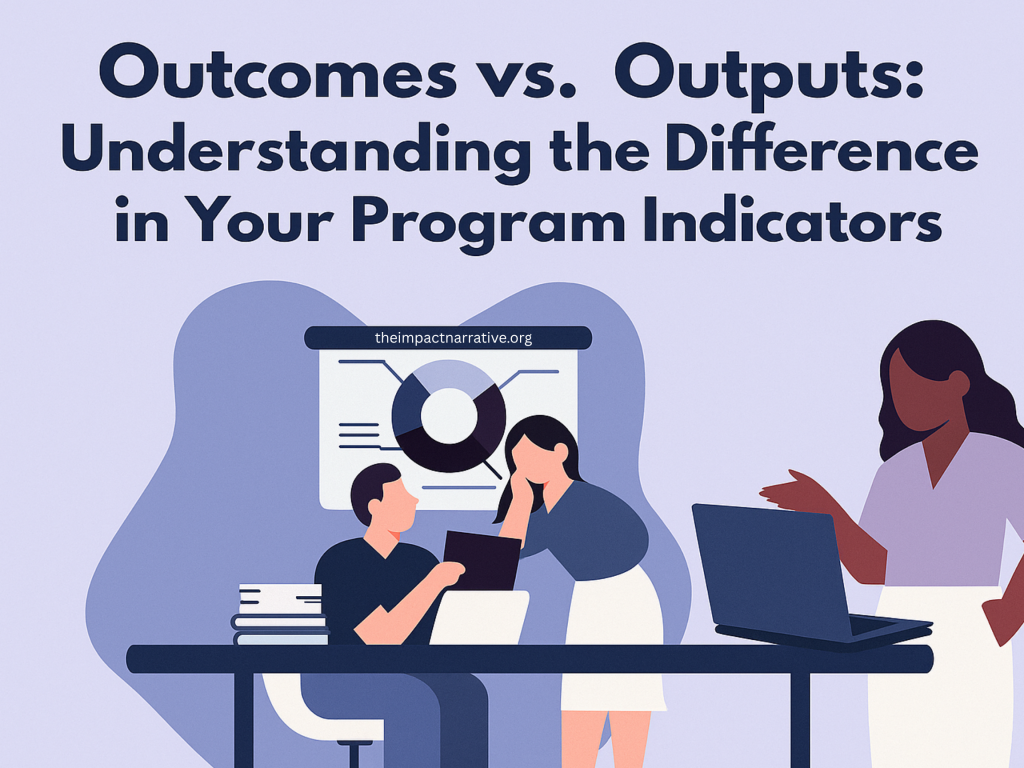Blog
Read stories and case studies from our work at the intersection of strategy, design, and impact. From evaluation insights to community-driven campaigns, we break down how data and storytelling drive better public health outcomes.

Outcomes vs. Outputs: Understanding the Difference
in Your Program Indicators
Whether you’re implementing a workforce initiative, launching a health campaign, or evaluating community partnerships, understanding the difference between outputs and outcomes is essential. This distinction helps public health teams move beyond activity tracking and toward measuring meaningful, community-level change.
Program evaluation becomes far more effective, and straightforward, when the foundation is clear and your indicators are aligned with both program goals and broader organizational priorities.
Outputs: What You Did
Outputs refer to your program’s activities or deliverables. These are the tangible things you produce, often easier to count but limited in showing actual change. Outputs are the activities we do or accomplish that help achieve outcomes.
Examples:
- Number of staff trained
- Number of staff engaged
- Number of workshops held
- Number of resident encounters or community events
- Number of materials distributed
- Number of health topics discussed
Outputs help you track what’s being done. But alone, they can’t answer whether your efforts led to lasting change.
Outcomes: What Changed Because of It
Outcomes measure the effects of your work, changes in knowledge, behavior, policy, or population health. They can occur at multiple levels:
- Individual: Improved knowledge or behavior
- Organizational: Strengthened systems, retention, equity
- Network or Systems-Level: Collaboration, resource alignment, policy impact
Examples:
- Increase confidence and technical skill in delivering care
- Organizations improve onboarding processes and invest in retention
- Networks reduce duplication and address resource inequities
- Clients report improved access to culturally competent services
Outcomes are harder to measure, but far more valuable for evaluating effectiveness and driving decisions.
Taking a Systems-Level Approach to Evaluation
In many public health initiatives and programs, especially those focused on workforce development or cross-sector collaboration—impact doesn’t happen in one place. It unfolds across multiple layers of the system. That’s why evaluation plans should differentiate outcomes by systems level: individual, organizational, and network-wide.
- At the individual level, outcomes might focus on how CHWs improve their technical skills, leadership capacity, or ability to manage burnout.
- At the organizational level, outcomes might address shifts in how agencies onboard, retain, and elevate CHWs, or how inclusive their workplace policies are.
- At the systems or network level, outcomes might evaluate how partners collaborate, share data, address resource gaps, and shift policies together.
By intentionally disaggregating outcomes across these layers, you create a roadmap that not only ensures strategic alignment but also helps stakeholders see where they fit and how their actions contribute to broader, population-level change.
Evaluation Frameworks: Building a Strong Foundation
So how do you structure this complexity into something usable? One of the most effective tools for aligning outputs, outcomes, and long-term impact is the Theory of Change.
Theory of Change is a framework that maps how and why a desired change is expected to happen in a particular context. It starts by identifying the long-term goals and then works backward to define the outcomes that must occur to reach those goals. Finally, it links those outcomes to specific program activities and strategies.
This approach helps teams define the “missing middle”—the steps between what they do and the results they hope to achieve.
With a well-articulated Theory of Change:
- You can identify the right indicators for each level of your program.
- Your activities are linked to a detailed understanding of how change unfolds.
- You can evaluate both immediate progress and long-term impact—moving far beyond simply counting activities.
Final Thoughts
Outputs help you show what you’re doing.
Outcomes help you show why it matters.
In public health, it’s easy to fall into the trap of counting activities and calling it progress—but funders, partners, and most importantly, communities, deserve a clearer picture. By distinguishing between outputs and outcomes, you create an opportunity to demonstrate the depth of your work—not just the breadth.
An outcome-driven approach shows that your program is more than busy—it’s strategic. It empowers teams to reflect, adapt, and improve over time. It helps leadership prioritize resources. It supports equity by asking not just what was done, but who benefited, what changed, and what still needs attention.
Ultimately, building evaluation frameworks that track meaningful change helps public health organizations:
Tell more powerful, credible impact stories
Strengthen accountability and transparency
Build trust with the communities they serve
Make smarter, more sustainable decisions
Whether you’re creating a logic model, setting indicators, or aligning cross-sector partners, grounding your work in outcomes builds the foundation for learning, improvement, and long-term change.
Need help developing outcome indicators or aligning them with your strategy?
Reach out for evaluation support grounded in equity, practicality, and real-world impact.

